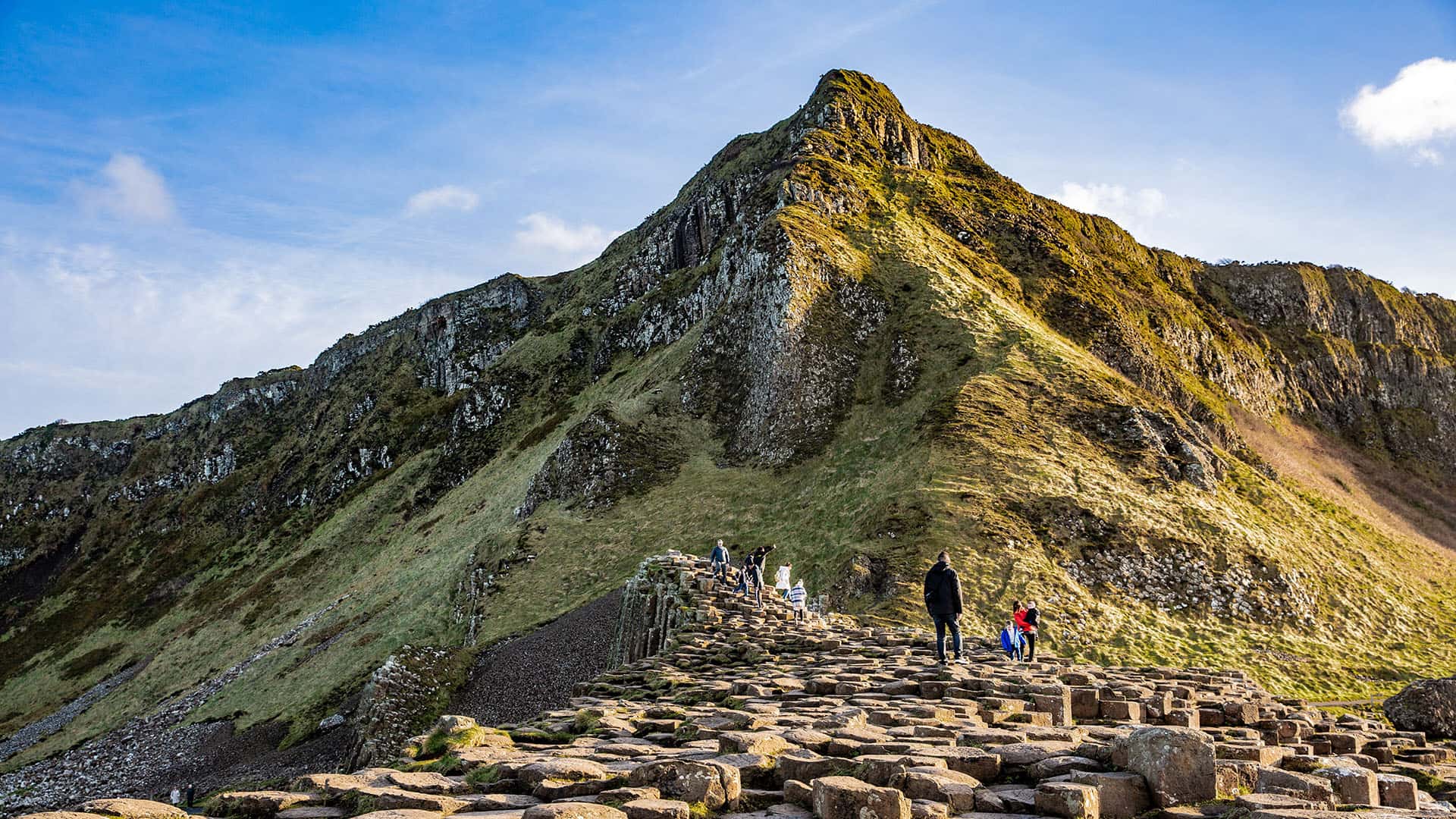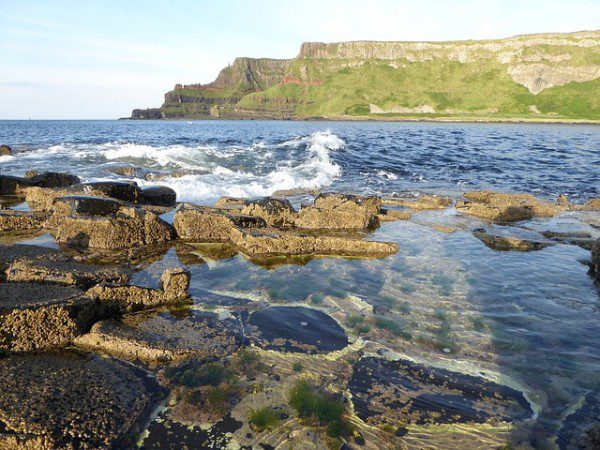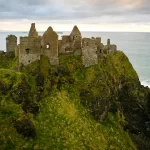The UNESCO World Heritage Site Giant’s Causeway is one of the top tourist attractions in Northern Ireland. It’s also one of the most unusual, yet most spectacular, natural features found anywhere in the United Kingdom. And as guests on our small-group tours of Ireland will confirm, it never fails to impress!
The Giant’s Causeway consists of thousands of basalt columns formed millennia ago by violent volcanic eruptions that changed the landscape forever. Legends abound at the Giant’s Causeway, and the natural spectacle is steeped in local lore as well as geological history, making it a fascinating place to explore.
It’s a must-visit destination and one of the most instantly recognizable sights in Northern Ireland. To help you plan your journey here, we’ve put together this detailed guide explaining everything you need to know about the Giant’s Causeway. If you have any questions for us as you read, please just get in touch.
What is the Giant’s Causeway?
The Giant’s Causeway is a surreal natural wonder. Basalt columns stretch along the coast, covering an area of several miles in Northern Ireland. These columns number around 40,000 and each is uniquely shaped and sized. The largest can reach heights of 12 meters and most are hexagonal, although each individual column is different.
The coastline surrounding the Giant’s Causeway is rugged and dramatic. The whole area is one of fascinating natural beauty, with excellent hiking routes, historic castles, and breathtaking views to enjoy. If this sounds like the kind of place you’d love to explore, we think you’ll appreciate taking a deeper dive with our Guide to Ireland’s Northern Coast.
The History of the Giant’s Causeway
The Giant’s Causeway is a truly ancient structure. The basalt columns were formed over 50 million years ago, and have been shaped and weathered ever since. Volcanic basalt seeped through the surface of the earth after a huge eruption. The molten rock then cooled slowly and, in a long geological process, the huge plain of basalt began to crack as the temperature lowered. This is how the basalt columns you can see today were shaped and formed.
Although the Giant’s Causeway has been steeped in local legend and known by the people in the surrounding areas for centuries, it wasn’t until 1692 that the ‘discovery’ of this natural wonder made it famous across the world.
The Royal Society began to produce drawings and papers on the Giant’s Causeway, and an unbelieving world initially refused to believe that something so perfect could be produced by the forces of nature alone.
It quickly became a popular tourist site, particularly amongst the European elite who were beginning to travel across the continent and were drawn in by such destinations. At first, it was unclear what had formed the Giant’s Causeway, and scientists and visitors threw around several stories. Many who saw the basalt columns couldn’t quite understand how nature could have created them; they even argued that it must have been workers using chisels that sculpted the rocks in an elaborate practical joke.
In the 18th century, geologists began to understand more about volcanic activity. This knowledge was applied to Giant’s Causeway, which people finally understood had been created millions of years ago, not by men, but by geological forces.
Ever since its ‘discovery’, the Giant’s Causeway has been a popular travel spot, and in recent decades visitor numbers have reached millions of people. Modern developments have included being listed as a UNESCO World Heritage Site, which occurred in 1986. The National Trust now manages the area in an effort to promote conservation and control the effects of mass tourism to this wild and beautiful part of Northern Ireland.
Read our Guide To Ireland’s UNESCO World Heritage Sites to find out which other locations on the island of Ireland have the same level of cultural and historical value.

Popular Myths Surrounding the Giant’s Causeway
Local legends attribute the rock formations to be the work of giants, a story that’s given the natural site its enduring name: Giant’s Causeway. It’s said that the legendary giant Finn McCool was protecting the coast of Northern Ireland from another giant in Scotland, just across the stormy seas.
The Scottish giant, Benandonner, wanted to pick a fight with Finn McCool and began to enrage his Irish counterpart. Finn McCool then used his strength to pick up huge pieces of the coastline, before hurling them into the ocean to build a causeway that would stretch across the sea, so he could battle with his nemesis.
The legends have proven popular in local history, and many different versions and retellings of the story have been passed down through the generations, but every tale revolves around giants building the rock formation.
This combination of myth, legend, geological marvels, and breathtaking natural beauty all add up to make Giant’s Causeway one of the top five places to visit in Ireland!
Where is the Giant’s Causeway, Northern Ireland?
The Giant’s Causeway is located on the far northern coast of Northern Ireland, a part of the wider United Kingdom. The site is within County Antrim, along what’s known as the Causeway Coast. The nearest town is a few kilometers away at Bushmills, while Belfast and Derry are around 90 kilometers and 70 kilometers away, respectively.
The Visitor Centre, located just a short walk from the coast, is the most popular access point to the Giant’s Causeway.
How to Get to the Giant’s Causeway?
The Giant’s Causeway is one of the most popular tourist destinations in the United Kingdom, so it has great transport links and infrastructure. There are several different ways to visit, ranging from public transport to private tours. If you are short on time and want to maximize your activities in Northern Ireland, then the most efficient method of travel is a group tour. These leave Belfast daily for the northern coast, and many combine a trip to the Giant’s Causeway with stops at other locations along the way. Of course, some of our own tours of Ireland visit the causeway too, including the 10-day Ultimate Ireland Tour and the 6-day Wild West and North Ireland Tour.
Belfast is often the main base for travelers in Northern Ireland, as there are great flight connections from the rest of the UK and to Europe. From Belfast, it’s just a one-and-a-half hour drive to the Giant’s Causeway, so you can rent a car and enjoy a road trip along the coast to see the rest of the area’s spectacular scenery at your own leisure.
If you are driving, you can either park at the Visitor Centre or drive to Bushmills and take the convenient park and ride for the last stretch to the entrance. The Bushmills option can be much less chaotic and much easier, given the huge number of cars and coaches trying to access the main entrance.
If you want to spend longer exploring the area, then you can stay in Bushmills and enjoy the local region rather than just passing through.
If you wish to take public transport from Belfast, it’s fairly simple to reach the Giant’s Causeway independently. It will take longer than your other options, although it will certainly be more cost-effective.
There is a direct bus, which takes approximately two hours, departing once a day at 9.30 am from the Europa Bus Centre in Belfast. The return journey departs at 2 pm. Fares are cheap, however the service only runs during peak season, usually from May through September. Unfortunately, the fact that it only runs there and back once a day also limits the time you can spend at the Giant’s Causeway, as well as limiting any flexibility you might want.
Another more flexible method of public transport available all year is to travel from Belfast to Coleraine, and then to change here to another service to the Giant’s Causeway. There are several services throughout the day and it’s very cost-effective, as you can buy a day ticket for the route.
When using public transport, double-check when the last return bus is if you need to get back to Belfast on the same day, as timings can change.
Most people will arrive at the Visitor Centre, regardless of their mode of transport, and from here it’s just a short walk down to the coast to see the Giant’s Causeway.
If you’re already writing down notes and planning an adventure in this part of the Emerald Isle, we think you’ll appreciate reading our Complete Guide to Visiting Northern Ireland when you have finished here.

When is the Best Time to Visit Giant’s Causeway?
The Giant’s Causeway can get incredibly busy, as it is one of the most visited attractions in the United Kingdom. Peak season is when the crowds will be at their worst; you’ll find most people choose to travel here in summer, generally between May and September. This is when the weather is at its best, so it’s when people flock here to enjoy the best outdoor activities in Northern Ireland.
If you visit during peak season, consider renting a car to drive here early in the morning or staying overnight nearby so you can arrive nice and early. The earlier you arrive at the Giant’s Causeway, the smaller the crowds will be.
If you don’t mind the cold weather and windswept coastline, it’s perfectly fine to travel here in winter too, and you’ll avoid most of the crowds. Be prepared with raincoats and warm clothing, as the weather can be particularly bracing.
The Giant’s Causeway is technically open all day as it’s public land, however, the Visitor Centre is open from 9 am until 6 pm in summer and from 9 am until 5 pm in winter. There is an entrance fee to visit the information center, where you can learn more about the human and geological history of the coastline, but the causeway itself is free.
Things to See and Do Near Giant’s Causeway
The Giant’s Causeway is one of the biggest reasons why Northern is worth visiting! Of course, it’s the main sight to see when you visit the north coast of County Antrim, and you’ll need at least an hour to truly appreciate the scale and volcanic beauty of the rock formations.
However, there’s more to do here if you have the time, and you can start by calling in at the excellent Visitor Centre, which is run by the National Trust and has a wealth of information.
Step Back in Time at Dunluce Castle
One of the best places to visit close to the Giant’s Causeway is Dunluce Castle. This ancient fortification dates back to the medieval era, but centuries of neglect and conflict have left it in ruins today.
The crumbling walls and towers are found in a dramatic location atop a rocky outcrop of basalt that stretches into the ocean. Legends abound here too, just as they do at Giant’s Causeway. There are tales of haunted towers and kitchens being swept away into the sea during mighty storms.
Embrace Adventure at Carrick-a-Rede Rope Bridge
Also looked after by the National Trust, Carrick-a-Rede is another stretch of spectacular coastline in County Antrim that shouldn’t be missed.
You can find a rope bridge here, which stretches precariously across a wide chasm, connecting the mainland with a small island off the shore. Fishermen originally built the bridge, and you can walk over the swinging planks while the wind howls for a truly adventurous experience.
Sample the Good Stuff at Bushmills Distillery
In the town of Bushmills, there’s a great local distillery creating some of the best whiskey in Northern Ireland. They have been distilling whiskey since the 17th century and you can tour the premises to learn more about their history and the production process.
The Best Walking Trails Around Giant’s Causeway
With such a rugged and spectacular coastline, one of the best things to do around the Giant’s Causeway is to lace up your hiking boots and start walking. There are some excellent trails along the coast of County Antrim and you’ll be spoilt for choice. Several trails lead to the Giant’s Causeway, and these can be a great option if you want to avoid the crowds and enjoy some unique views of the rock formations.
The Red Trail is a short hike of one hour that takes you along the coast one way from the Visitor Centre and to some of the best viewpoints over the Giant’s Causeway. The Blue Trail only takes half an hour and leads you directly to the main collection of rocks, with the option to then link up with the Red Trail.
If you are looking for a real adventure, then you can take on the Causeway Coast Trail, a long-distance hiking route that takes two or three days to complete and takes you along much of the northern coast of County Antrim.
Our blog What To Look For In A Hiking And Trekking Tour In Ireland is a great resource for anyone looking to hit the trails while in the Emerald Isle.
Find Out Which of Our Ireland Tours Visit Giant’s Causeway!
If you’d like to visit the Giant’s Causeway as part of a small-group Ireland tour, check out our great range of itineraries or contact Overland Ireland to find out more.







